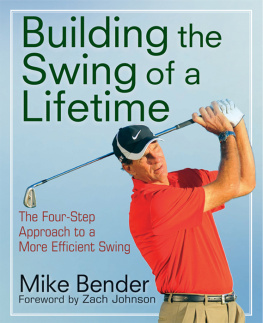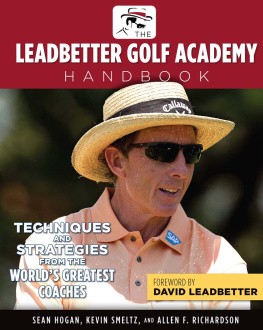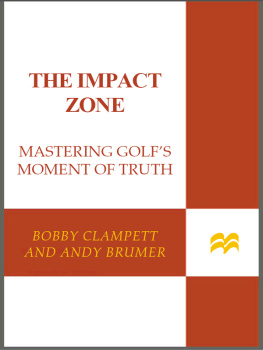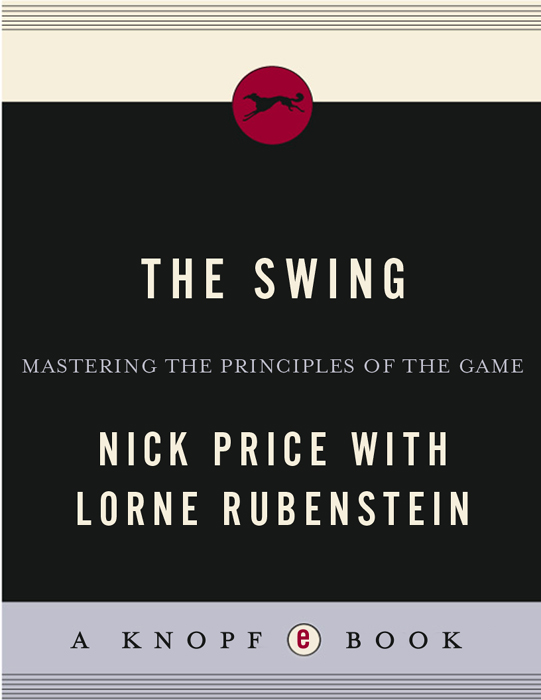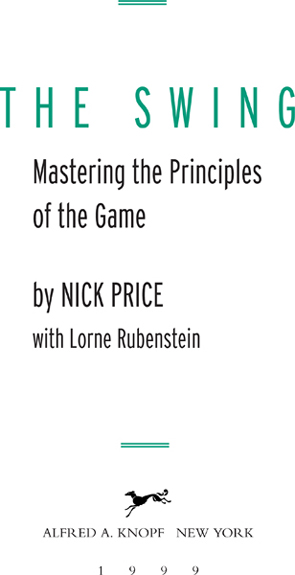one
THE ONE ESSENTIAL: PERSEVERANCE
two
OUT OF AFRICA
three
THE THEORY OF THE EFFICIENT SWING
four
THE GRIP
five
THE SETUP
six
THE TAKEAWAY AND BACKSWING
seven
THE DOWNSWING
eight
THE SHORT GAME
nine
EFFICIENT PUTTING
ten
SWING SEQUENCES
eleven
SWING JOURNAL
twelve
THOUGHTS FOR EFFICIENT GOLF
While playing the golf circuits of the world, it is very hard to form meaningful relationships with ones fellow competitors. It takes a unique kind of personality to bridge that gap between a rival and a fellow competitor.
Nick Price is one of those rare individuals. He is loyal, supportive, and a great friend to sit down and have a few beers with, without our respective golf careers ever getting in the way. He is someone I have the highest regard for and would consider one of my closest friends. We derive as much pleasure out of each others victories as we do out of our own. Nick is always leaving little quips and messages to boost me on, cheer me up, or congratulate me, and vice versa. I am proud to call him my friend. I believe he is one of the great players of the Tour. When Nick is on a roll, look out, because he is a fierce competitor and a man of awesome talent.
I am sure you will find in this book a reflection of this great human being, a man who is loved and respected by all in the golfing community.
Greg Norman
Having known Nick Price since he was ten years old, I have strong recollections of his aggressive swingeven at a young age. His fast tempo has always been a trademark. With the great improvement in his swing over the years, Nick has always been able to maintain his natural tempo despite the criticism that he would be better off if he swung slower. The proof of the pudding has been his tremendous results over the past few years.
When we first started on swing changes in the winter of 1981, Nick had a lot of wasted motion; combined with excessive leg action, this produced a lot of inconsistent shots. Since those early days, it has been a matter of continually refining his technique based on those early faults. What this has shown is that certain tendencies in ones golf swing are always thereyou just have to keep working on them.
Since a lot of the work was trial and error, it has been a real learning experience for both of us. I know that working with Nick has enhanced my overall teaching ability. His great talent and undying search for perfection have brought great rewards, and it is no mean accomplishment when his peers say he is one of the best ballstrikers of all time. When he is on his game (which is frequently these days) Nick hones in on the pins, and strikes the ball in such a way that the contact sounds like a bullet being shot out of a guna sound only a few great players can claim to own. His book will help golfers of all levels understand just what it takes.
David Leadbetter
One of the reasons golf is such a fascinating game is that it offers every golfer legitimate hope of improvement no matter his or her age. As Nick Price shows in these pages, a golfer can be better at age sixty than fifty, fifty than forty, or forty than thirty. In golf, older can really mean better simply because we can learn about our swings, and by thoughtful practice and application we can gradually reduce the influence of our bad habits. This is not to say that those habits wont always be with us. David Leadbetter, with whom Nick worked to improve his own swing, believes that traces of the first swing remain throughout the golfers lifetime. But this only means that we need to be on guard against our particular mistakes and to understand that these faults will tend to creep in when we least expect them. Theres no taking anything for granted in golf; this is certain.
But a golfer can be confident of improvement if he or she takes a long-term approach to change. And that is what caught my interest when I first watched Nick play golf during the early 1980s. I remember a chat we had during a tournament when he was frustrated because he was not winning on the PGA Tour but said with conviction how he felt that one day the gates would open wide for him and he would win. He was speaking a fundamental truth here, I think. Nick was saying that his swing was improving and that this progress would result in lower scores. He was becoming more consistent: His shot patterns were more to his liking, the ball flight was more uniform. Maybe he wasnt shooting the low numbers consistently enough to win, and maybe he was shooting too many 73s and 74s, which always hurt during a tour event, but the significant factor was that Nick was progressing.
Through his own trials, Nick learned a great deal. He learned that the golfer who wants to improveto really improveneeds a sense of humor, because things do not always go according to plan. Having a long-term plan that makes sense and that incorporates sound principles is no guarantee that there wont be obstacles. Golfers, like anybody engaged in a discipline of refinement, must be able to laugh at themselves, to take the good with the bad. Happily, Nick has been able to do that. The life of any professional golfer is full of unusual happenings that help ease the way, as long as the player can see situations with some humor. In the course of following Nick over the years, interviewing him for articles, and then working on this book, I learned that his ability to take things in stride and to appreciate the lighter side of the golf professionals life has quite a bit to do with his play on the course.
In this regardtaking the bad with the good and appreciating how very little works out exactly as one wantsI think of something Robert Frost told the writer Roger Kahn. Kahn was in Vermont, where he was interviewing Frost for an essay he would write. During one exchange he asked Frost if his method of writing had changed over the years.
If Im not in shape so I can strike it out, like a good golf stroke or a good stroke of the bat, theres not much I can do, Frost told Kahn. Oh, you get so that some days you can play a beautiful game, but there are always days when you cant. Those days, I cant redo them. Theyre done. Down the sink.
What some seem to do, Frost continued, is worry a thing into shape and have others worry with them. Not to say I dont have the distress of failure, but the worry way isnt for me. There are the days you can and the days you cant, and both are training toward the future days you can.
I have often thought of those last words: both are training toward the future days you can. Nick knew this when he was working in those dry days of no tournament wins from 1983, when he won the World Series of Golf, until 1991, when he won the Byron Nelson Classic. Nick was sticking to what he knew was best for him; he had seen the improvement in the flight of his golf ball, in the way it was taking off more often exactly down the line he aimed, in the way it penetrated through a strong wind. Power, accuracy, control: Nick was on the right track and was not straying from the path he had chosen. Never mind the days when he couldnt, or even the days when he could. He was thinking about the long run; he was looking to the future.


